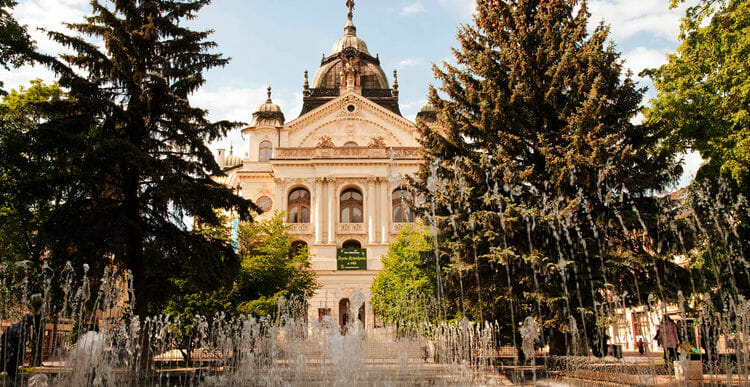Kosice
Hotels
Stays
Turist information
History
Košice – one of the oldest towns in Slovakia – lies at the place where the River Hornád emerges from its picturesque wooded valley and flows onto an extensive plain. This is a city with a rich and glorious past. It starts with the first mention of a community here in a document from the year 1230, when Košice is referred to as “Villa Cassa”. The town itself was founded by German colonists from Lower Saxony together with the original local Slav settlers after the year 1243. It is assumed that in 1290 Košice acquired town privileges, with the right to hold markets and fairs, collect taxes and build fortified walls. Further privileges granted in 1342 and 1347 gave Košice the status of a free royal town, ranking it as one of the leading centres of Greater Hungary. Then in 1369 King Ludovicus Magnus granted Košice a coat of arms, making it absolutely the first town in Europe to use such a symbol on the basis of a royal armorial warrant. Following the period of economic flourishing and relative peace in the 14th and 15th centuries, Košice in the 16th and 17th centuries experienced troubled times as a result first of the Turkish invasion threat, then the religious conflicts of the Reformation and Counter-Reformation, and later the series of aristocratic rebellions against the Habsburgs. Despite repeated armed clashes, during this time the Jesuits were able to make Košice a seat of learning with its own university and secondary schools. The confusion of the incipient Modern Age gave way to peace and progressive growth in the 18th and 19th centuries. The new Baroque architecture flourished here, followed by neo-Classicism and Romanticism; the aristocracy moved into the town, promoting the arts, theatre and social life. By the end of the 19th century Košice had developed into one of the most important industrial cities in Greater Hungary. In 1918 Košice became part of the first Czechoslovak Republic, and although the wartime Hungarian occupation from 1938 to 1945 brought economic and demographic decline, at the end of the Second World War Košice for a while became the capital of the re-established Czechoslovakia. From the 1950’s onwards the city experienced furious growth, accelerated mainly by the building of the East Slovakian Steelworks. In the space of one generation there was a five-fold increase in the city’s population, and a twenty-fold expansion in its built-up area.
Location and climate
The city occupies the Košice Basin formed by the wide valley of the River Hornád, contained by the outlying ridges of the Slovakian Ore Mountains to the west and the Salt Hills to the east. The city centre lies at 208 metres above sea-level, and the climate in Košice is moderately warm with average temperatures of 19° C in July and -3° C in January.
Tourist attractions
Anička
This recreation area is situated within the Košice-North city ward. There is an extensive park with a mineral water spring and a tennis centre, and there is a children’s play area with a classic mini-golf course. This area is fenced in and supervised, so that parents with young children especially can enjoy themselves in safety.
Bankov
This very popular place for relaxation, sport and entertainment is accessible by car and city bus and offers good conditions for hiking and mountain-biking, facilities for barbecuing and picnicking, and a minigolf course. There is also an exclusive hotel.
Hradová
In the past this was the site of a medieval castle (probably 14th century) with a good strategic vantage point. At the present this hilltop is better known for the 21-metre high look-out tower offering panoramatic views over the city and the Košice Basin, but it is also possible to walk around the remains of the castle fortifications.
Bukovec
Reservoir near the village of the same name. Facilities for swimming, water sports and fishing. In the grounds of the Hrabina Hotel there is a six-hole golf-course and a golf training simulator.
Surroundings
Izra
This lake of volcanic origin has an area of 3.7 hectares and lies amidst the beech forests in the southern part of the Slanské vrchy (Salt Hills).
Zádiel Canyon
The natural treasures of Zádiel Canyon make it surely one of the most attractive features of the Slovak Karst region. Due to its unique flora, fauna and natural scenery it has long been a protected landscape area. The length of this limestone canyon is 2200 metres and the rocky sides rise to around 300 metres at their highest. An instructive nature trail leads up the canyon.
Slovak karst national park
This is the largest karst area in Europe, featuring more than 400 caves and pot-holes. Twelve of them are registered in UNESCO’s World Cultural and Natural Heritage List.
Slovak paradise national park
This extends over an area of 32 774 hectares, and incorporates 18 special nature reserves. There are wonderful karst plateaus, ravines, waterfalls and caves to be found here. The whole area of the Slovak Paradise is characterized by extreme variety of flora and fauna.
Nižná Myšľa
This village is a significant archeological site with Bronze Age settlements and burial places dating from 1450 BC, as well as recently discovered remains of a medieval church from the late 13th century.
Herľany
This village features the only cold-water geyser in Europe, with a jet of mineral water erupting from a depth of 450 metres and between 20–30 metres into the air at approx. 32 to 34-hourly intervals.
Jasov
This historically important village was known as early as in the 12th century. At that time the Premonstratensian Order built a fortified monastery here, but it was burnt down together with the village during the Tartar invasions. The present monastery dates from the 18th century, and it is the most beautiful late-Baroque building in Slovakia.




